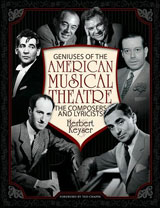
Uninspired history gets star treatment
|
This review first appeared in Turbula in November 2009.
Collectively, the men and women who composed songs for Broadway (and, to a lesser extent, Hollywood) from the 1920s through '60s created what we call today "The Great American Songbook." Their names are synonymous with great music: Lerner and Lowe, Gershwin, Rodgers and Hart, Rodgers and Hammerstein, Loesser, Kern, Warren, Styne.
Not only did they create hit after Broadway hit – "Show Boat" to "Oklahoma!" to "The King and I" – but their songs were the raw material that the 20th century's best singers used to create their signature performances. Try to think of Bing Crosby's career without "White Christmas" (Irving Berlin) or "Star Dust" (Hoagy Carmichael), Sinatra without "I've Got You Under My Skin" (Cole Porter) or "Luck Be a Lady" (Frank Loesser) or Ella Fitzgerald without her collection of "songbooks" built around the works of a single songwriter.
Herbert Keyser's new collection of biographies does a nice job of collecting the life stories of the composers and lyricists of Broadway, from the generation that created the modern musical in the 1920s to current megastars Stephen Sondheim and Andrew Lloyd Weber. Each biography gives a bit of family background, the childhood of each subject, their introduction to music and their struggles and successes (and often struggles again).
Although the stories are complete, they could have used some editing. Keyser at times repeats information he's already covered, and while the biographies are mostly linear, at times he unexpectedly (and jarringly) bounces around. In addition, the focus is often a bit heavy on their love lives and sexual indiscretions – most of which aren't really germane to the music.
What's really missing here, though, are more thoughts of the songwriters themselves. There are far too few inclusions of what they thought of their work, and when we do get that, it's generally from a paraphrased reference: "He always thought it was his best song," rather than an actual quote.
While Keyser doesn't appear to have done much, if any, primary research on his own (instead capsulizing full-length biographies), this is a handy volume to have for its all-in-one nature, providing basic biographical information on everyone from Fats Waller and Jerome Kern (who were writing early last century) up through the present. The bibliography and footnotes also provide a nice starting point for readers interested in learning more.
And the book is absolutely gorgeous – an oversized coffee table-sized volume printed on heavy-stock paper and loaded with photos of the subjects. The dust jacket is similarly high-class, and the chart of each composer's hit shows that closes each chapter offers a nice summation of their career.
Keyser's writing may not fully deliver on the promise of the stellar packaging, but it is a fun, informative read about some truly creative people.

